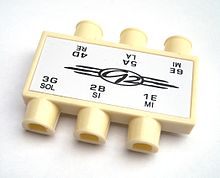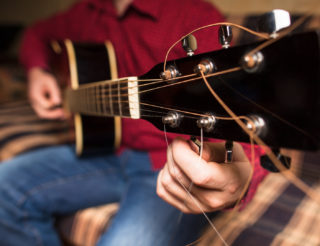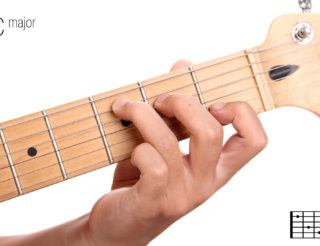10 Easy Ear Training Techniques Every Beginner Guitar Player Should Use
Author: Chloe Marshall

Whether you’ve been playing guitar for a while or are just starting out, ear training should be an important part of your practice regime. Among many other benefits, by developing your aural (listening) skills you’ll find it easier to tune your guitar and learn songs without having to read tab/notation. That being said, it’s not always easy to find an ear training method that works for you. If you are a beginner or an intermediate guitar player, I highly recommend you to download the free Uberchord app (click to download) for practicing your chords. The app listens to you play guitar and provides you instant feedback and even tracks your daily progress. While you practice your guitar, just follow these 10 ear training hacks and you are surely gonna see the difference within few days.
Table of Contents
1. BRUSH UP ON YOUR THEORY
 What does this have to do with ear training, you ask? Quite a lot actually. Although some people naturally have a great ear, most of us will need all the help we can get to become familiar with the various rules that form the basis of most of the music we listen to. Regularly practising your theory– especially the stuff regarding how notes work together to form chords, and how scales and modes work- will give you regular interaction with (and allow you to develop a better understanding of) all of the sounds you’re planning on identifying by ear, which puts you in a really good position to throw out the tab/manuscripts for a bit to start further developing your listening skills later on. Musictheory.net is a fantastic (free) place to start.
What does this have to do with ear training, you ask? Quite a lot actually. Although some people naturally have a great ear, most of us will need all the help we can get to become familiar with the various rules that form the basis of most of the music we listen to. Regularly practising your theory– especially the stuff regarding how notes work together to form chords, and how scales and modes work- will give you regular interaction with (and allow you to develop a better understanding of) all of the sounds you’re planning on identifying by ear, which puts you in a really good position to throw out the tab/manuscripts for a bit to start further developing your listening skills later on. Musictheory.net is a fantastic (free) place to start.
2. PLAY SCALES

Do this as often as possible and learn as many scales as possible. Start with playing the blues guitar with the 5 Pentatonic scale patterns, it’s really and fun to play. While you’re playing it, try saying each note name out loud. This will help your brain begin to associate a certain note name with its pitch sound on the guitar. Bonus: it will also help you start to navigate the fretboard a lot quicker, so it’s a win-win really!
3. PRACTICE YOUR INTERVALS
Interval training is super important for any musician trying to develop their aural skills. Basically, it’s training yourself to recognise the relationship between two notes of a scale when they’re played one after the other. As intervals tend to form a fundamental part of many melodies, knowing what each one sounds like will put you well on the way to better identifying the note sequences you hear in songs. It might take some time to get used to, but there are plenty of resources online ready to help you out. Take a look at the online music intervals tutor which listens to intervals or watch this video below:
 4. USE A TUNING FORK OR A PITCH PIPE
4. USE A TUNING FORK OR A PITCH PIPE
This one is more to help you with tuning your guitar by ear. Tuning forks or pitch pipes come in a range of pitches, but for guitar you want one that resonates on the same frequency as E so that you can begin tuning your lowest string. Practice humming along with the sound you hear and you’ll have it memorised in no time.
5. ROOT NOTE IDENTIFICATION EXERCISE
 This one is really great because you can do it whenever and wherever you want – as long as you have some music to listen to. Simply try to find the root note underlining each chord of your favourite songs and hum along. It might take some time to get it right, but you’re basically aiming to blend the pitch of the note you’re humming with the root note of the song- so if it sticks out slightly or sounds unpleasant, you’ve still got work to do!
This one is really great because you can do it whenever and wherever you want – as long as you have some music to listen to. Simply try to find the root note underlining each chord of your favourite songs and hum along. It might take some time to get it right, but you’re basically aiming to blend the pitch of the note you’re humming with the root note of the song- so if it sticks out slightly or sounds unpleasant, you’ve still got work to do!
*Not sure what root notes are? Check out this video:
6. MELODY IDENTIFICATION EXERCISE
This follows on from the root note exercise. Once you’ve found the root note, you’ve also put yourself in a good position to find the chord, which means you’re one step away from being able to figure out the melody to the song. Grab your guitar and start listening to a song with a relatively simple melody. From here you can begin to try and figure it out. Start small by aiming for a part of the song that has a well- defined melodic arc (the chorus is usually your best bet) and try to identify each note on your guitar. There are two ways of doing this, depending on your preference.
The first is to work out the root note, identify the chord (or google the chords if you find this too hard at first) and then use your knowledge of what chord is supporting the melody to work out what notes are being used. HINT: The notes used in the melody are often taken from the chord itself (with a couple of exceptions), so start with those and then experiment from there.
 7. SING! SING! SING!
7. SING! SING! SING!
I’m probably the first to admit that every time someone told me to sing along while playing the guitar they would receive a less than enthusiastic response. That being said- they were right. When we sing along with the notes we play (even if you think you’re a terrible singer), our brains are going to an extended effort to process the pitch of the note we hear so as to accurately repeat it back with the voice. This means that if you practice singing along with an awareness of the note names you’re aiming for, you’re going to start building the skills you need to be able to recognise notes by ear- just by singing along!
8. BECOME FAMILIAR WITH COMMON CHORD PROGRESSIONS
 A large majority of the songs you listen to will rely on some variation of a II, V, I (2, 5, 1) chord progression or I, IV, V (1, 4, 5). That is, they will often either drift between the first, fourth and fifth chord of a major scale (common in pop/rock music), or between the second, fifth and first chord (more common in jazz). Becoming adept at recognising these progressions as they occur can often be a quick and easy way of working out the chords to a song- which is essentially a practical ear training exercise in itself. Here are a video links to help:
A large majority of the songs you listen to will rely on some variation of a II, V, I (2, 5, 1) chord progression or I, IV, V (1, 4, 5). That is, they will often either drift between the first, fourth and fifth chord of a major scale (common in pop/rock music), or between the second, fifth and first chord (more common in jazz). Becoming adept at recognising these progressions as they occur can often be a quick and easy way of working out the chords to a song- which is essentially a practical ear training exercise in itself. Here are a video links to help:
I, IV, V:
II, V, I:
https://www.youtube.com/watch?v=IGT3-0GxIjs
9. DICTATION AND TRANSCRIPTION
 This is one of the more traditional methods of ear training but it’s a classic for a reason. It relates to listening to a melody (or rhythm) and writing down what you hear on manuscript. Obviously it will work better if you have a good understanding of musical theory first- so at least make sure you know the notes on the staff before you try this one. If you’re interested, Teoria offers quite a helpful training exercise.
This is one of the more traditional methods of ear training but it’s a classic for a reason. It relates to listening to a melody (or rhythm) and writing down what you hear on manuscript. Obviously it will work better if you have a good understanding of musical theory first- so at least make sure you know the notes on the staff before you try this one. If you’re interested, Teoria offers quite a helpful training exercise.
10. PLAY, PLAY & PLAY!
 When it comes down to it, one of the things that will help most in terms of training your ear is to actually sit down and play your guitar. The more we do this, the more we will develop an inherent understanding of pitch and how it relates to guitar; and music as a whole. Close your eyes and listen to the chords closely when you practice using Uberchord app. Explore the fretboard as often as you can. Play for fun, play to practice, play to perform- and do it as often as you can!
When it comes down to it, one of the things that will help most in terms of training your ear is to actually sit down and play your guitar. The more we do this, the more we will develop an inherent understanding of pitch and how it relates to guitar; and music as a whole. Close your eyes and listen to the chords closely when you practice using Uberchord app. Explore the fretboard as often as you can. Play for fun, play to practice, play to perform- and do it as often as you can!
There is no better way to practice ear training that to learn songs and identify some of the theory principles behind them. We cover topics on our free blog like chords in the key of f minor, what are chord inversions, and easy arpeggios on guitar. The tips in this article and blogs like these will help out immensely!


 4. USE A TUNING FORK OR A PITCH PIPE
4. USE A TUNING FORK OR A PITCH PIPE 7. SING! SING! SING!
7. SING! SING! SING!





No comments yet - be the first.